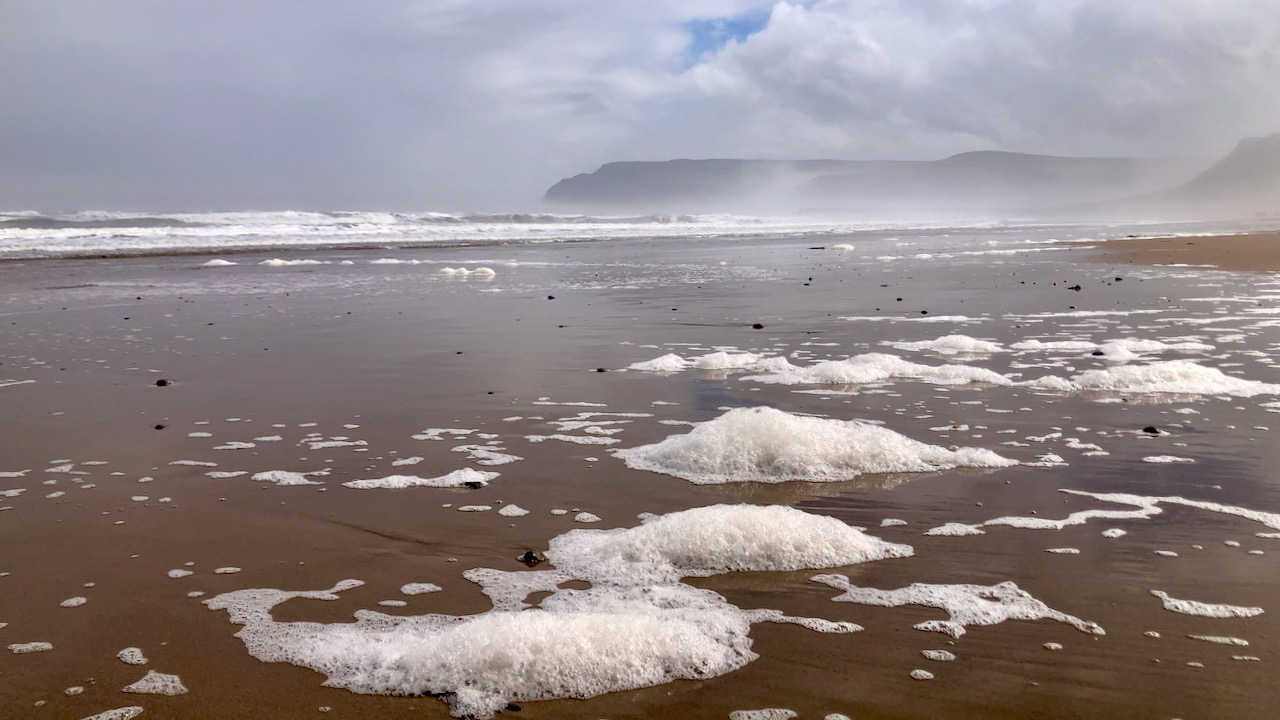A visit to the sea-side.
Back at home, we had woken up to a wet but mild morning. However, the scene at Cattersty Sands was a different world. A sea fret unfurled before us, though glimpses of blue peered above sporadically. Typically, the surf maintains a steady rhythm, a predictable ebb and flow. Yet on this morning, all semblance of regularity had dissipated. The waters churned with a fervour bordering on tumult. It actually looked dangerous. Perhaps this was not a sea fret, but rather an onslaught of ‘sea spray‘.
As the waves rolled back after breaking on the sands, patches of ‘spume’, or sea-foam, remained1“foam, frothy matter in fluids or liquids,” late 14c., from Old French spume, espume and directly from Latin spuma “foam”, which is cognate with Old English fam, Old High German veim “foam”. Also from 14c. as a verb, “to foam or froth,” from Latin spumare.. This phenomenon arises from the agitation of seawater saturated with natural constituents derived from plankton and algae. Such constituents act like surfactants found in bubble baths, diminishing the water’s surface tension and facilitating the formation of resilient bubbles. Instances where copious organic matter meets tumultuous seas have, on occasion, yielded substantial volumes of spume. So sea-foam is a natural occurrence.
Over the years, sea foam has found its place within poetry and storytelling. Hesiod, the Greek farmer-cum-poet who wrote the Theogony, the saga detailing the origins of the Greek pantheon, posited that the goddess Aphrodite was born from sea-foam. On the other hand, in Hans Christian Andersen’s “The Little Mermaid,” not the Disney film, the story culminates with the mermaid flinging herself from a cliff, plummeting into the ocean depths, and transmuting into the very essence of sea foam. So sea-foam has been an apt metaphor for poets, symbolising life’s transient essence with its emergence from nothingness and subsequent dissipation.
But, whilst sea foam arises naturally from the agitation of seawater mingling with organic substances, human endeavours can exacerbate its proliferation, often resulting in noxious foam. Our seas have found themselves thrust into unwelcome scrutiny of late. I have read reports indicating that 2023 marked a record for sewage discharge, with nearly half a million such occurrences documented, wreaking havoc upon the ecosystem and imperilling both wildlife and public health2Laville, Sandra, and Helena Horton. 2024. ‘4m Hours of Raw Sewage Discharges in England in 2023, Data Expected to Show’, The Guardian (The Guardian) <https://www.theguardian.com/business/2024/mar/26/4m-hours-of-raw-sewage-discharges-in-england-last-year-figures-expected-to-show> [accessed 3 April 2024]. Though these episodes may originate in our rivers, their ultimate destination is the sea. Might this portend a surge in the prevalence of sea foam?
- 1“foam, frothy matter in fluids or liquids,” late 14c., from Old French spume, espume and directly from Latin spuma “foam”, which is cognate with Old English fam, Old High German veim “foam”. Also from 14c. as a verb, “to foam or froth,” from Latin spumare.
- 2Laville, Sandra, and Helena Horton. 2024. ‘4m Hours of Raw Sewage Discharges in England in 2023, Data Expected to Show’, The Guardian (The Guardian) <https://www.theguardian.com/business/2024/mar/26/4m-hours-of-raw-sewage-discharges-in-england-last-year-figures-expected-to-show> [accessed 3 April 2024]

Leave a Reply